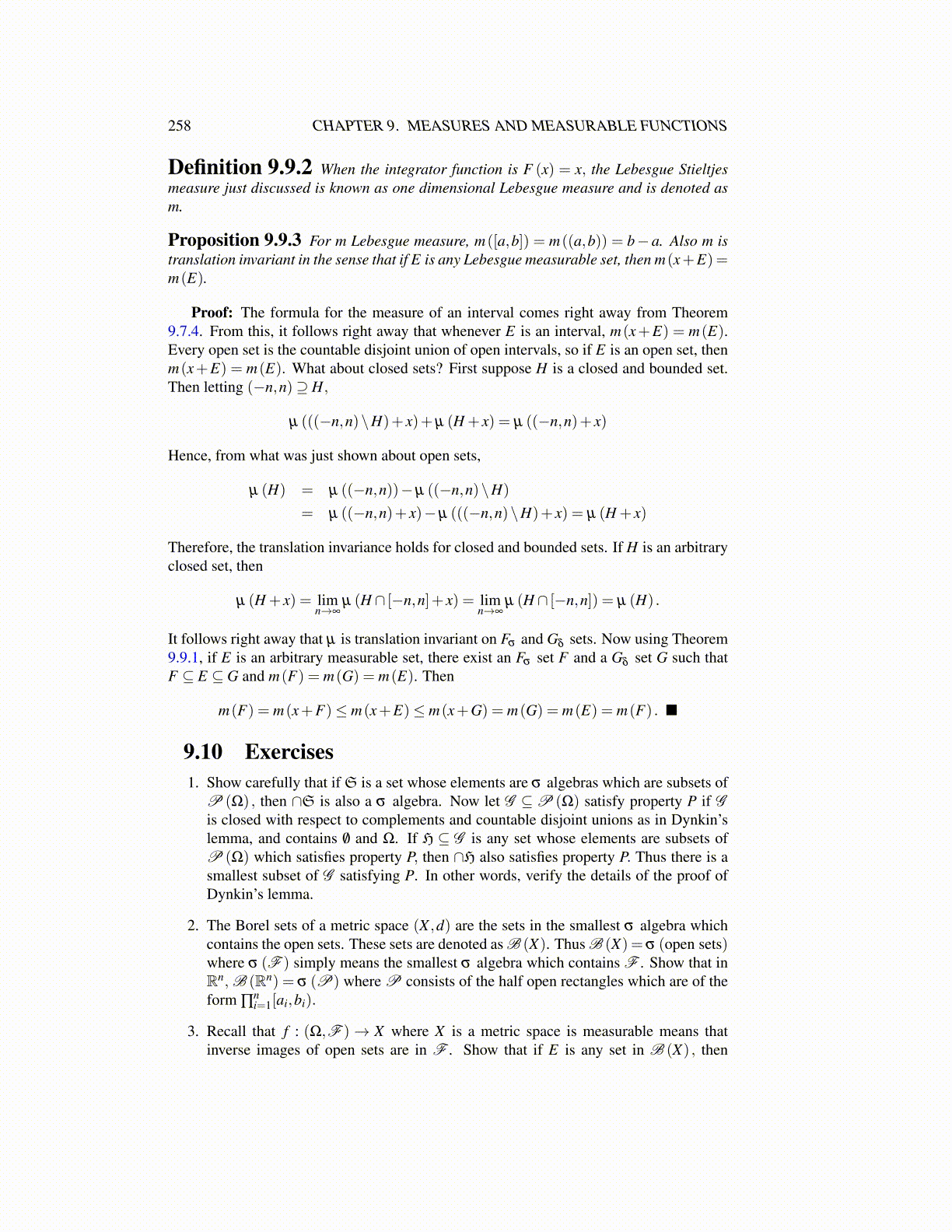
258 CHAPTER 9. MEASURES AND MEASURABLE FUNCTIONS
Definition 9.9.2 When the integrator function is F (x) = x, the Lebesgue Stieltjesmeasure just discussed is known as one dimensional Lebesgue measure and is denoted asm.
Proposition 9.9.3 For m Lebesgue measure, m([a,b]) = m((a,b)) = b− a. Also m istranslation invariant in the sense that if E is any Lebesgue measurable set, then m(x+E)=m(E).
Proof: The formula for the measure of an interval comes right away from Theorem9.7.4. From this, it follows right away that whenever E is an interval, m(x+E) = m(E).Every open set is the countable disjoint union of open intervals, so if E is an open set, thenm(x+E) = m(E). What about closed sets? First suppose H is a closed and bounded set.Then letting (−n,n)⊇ H,
µ (((−n,n)\H)+ x)+µ (H + x) = µ ((−n,n)+ x)
Hence, from what was just shown about open sets,
µ (H) = µ ((−n,n))−µ ((−n,n)\H)
= µ ((−n,n)+ x)−µ (((−n,n)\H)+ x) = µ (H + x)
Therefore, the translation invariance holds for closed and bounded sets. If H is an arbitraryclosed set, then
µ (H + x) = limn→∞
µ (H ∩ [−n,n]+ x) = limn→∞
µ (H ∩ [−n,n]) = µ (H) .
It follows right away that µ is translation invariant on Fσ and Gδ sets. Now using Theorem9.9.1, if E is an arbitrary measurable set, there exist an Fσ set F and a Gδ set G such thatF ⊆ E ⊆ G and m(F) = m(G) = m(E). Then
m(F) = m(x+F)≤ m(x+E)≤ m(x+G) = m(G) = m(E) = m(F) . ■
9.10 Exercises1. Show carefully that if S is a set whose elements are σ algebras which are subsets of
P (Ω) , then ∩S is also a σ algebra. Now let G ⊆P (Ω) satisfy property P if Gis closed with respect to complements and countable disjoint unions as in Dynkin’slemma, and contains /0 and Ω. If H ⊆ G is any set whose elements are subsets ofP (Ω) which satisfies property P, then ∩H also satisfies property P. Thus there is asmallest subset of G satisfying P. In other words, verify the details of the proof ofDynkin’s lemma.
2. The Borel sets of a metric space (X ,d) are the sets in the smallest σ algebra whichcontains the open sets. These sets are denoted as B (X). Thus B (X) = σ (open sets)where σ (F ) simply means the smallest σ algebra which contains F . Show that inRn, B (Rn) = σ (P) where P consists of the half open rectangles which are of theform ∏
ni=1[ai,bi).
3. Recall that f : (Ω,F )→ X where X is a metric space is measurable means thatinverse images of open sets are in F . Show that if E is any set in B (X) , then